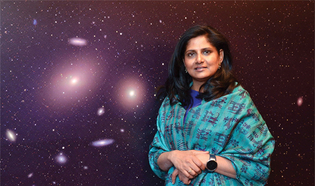
Michael Marsland
To most people on Earth, the universe is something to take for granted—-moon, stars, constellations. But as Priyamvada Natarajan can tell you, it is tremendously more complex.
View full image
Listen to someone who knows something about astronomy, and you will probably be interested. Listen to Priyamvada Natarajan on astronomy, and you’ll be completely fascinated. You’ll also find yourself gasping at mind-stretching episodes in the universe, episodes that surely, certainly, don’t really happen? But yes: they do.
We all know the universe has many black holes. A large percentage of us (myself included, until now) likely imagine those black holes as dead stars that burned out like candles, each one leaving a charred, solid lump. But Natarajan, the Joseph S. and Sophia S. Fruton Professor of Astronomy and Professor of Physics, explained to me that a black hole is much more enigmatic. The dead star eventually dwindles to a pinpoint so small, so dense, and so unimaginably heavy that it closes in on itself—and disappears. Natarajan calls the result “a puncture in space-time.”
Where does the impossible object go—that hugely massive star that forces itself into a hugely massive nothingness? Natarajan, along with all other eminent astronomers, doesn’t know. “Maybe another universe,” she said. “We have no idea.” But she does know that any black hole bends space-time very strongly. She also knows that if starlight beams into that puncture, it will never come back, because it has entered what is called “the singularity.” In the singularity, explains Natarajan, “all known laws of physics break down.”
There’s much more to the weirdness of the cosmos. Light beaming from an object nearby can bend around a black hole. And then there are other oddities among the black holes. Some are tiny; some—the supermassive black holes, defined as anything a million times or more of the mass of our sun—are unbelievably gigantic. And consider the Big Bang of 13.8 billion years ago, which created the universe. How and where could it have come from?
Natarajan and her team have worked for years on simulations and models to understand the origin of the first black holes. They developed the terms “heavy seeds”—black holes that form from the collapse of gas—and “light seeds,” remnants of the stars that had exploded. They found that in the early universe, the conditions for developing heavy seeds could indeed have existed. In other words: it was very likely that even back then, both heavy and light seeds—progenitors of the supermassive black holes we see today in the center of most galaxies, including our own Milky Way—had been forming, and glowing. That encouraged Natarajan’s team to continue working on the mystery of the formation of black holes via heavy seeds. They also felt encouraged, she said, to “make bold predictions for the detection of unique signatures that would confirm the idea.”
One of the most fascinating parts of the work Natarajan described to me concerned quasars: “actively growing black holes” that are supermassive—so much so that their gravity pulls in gas, and the gas, heating up, begins to glow with extraordinary brightness. “That’s what you see as the quasar light: the dying gasps of the gas before it is pulled in,” she said.
Last February, Natarajan produced another astonishing piece of work. It involved the discovery of a very distant supermassive black hole candidate, along with the detection of X-rays that poured out from the emissions of the gas around it. “If you see X-rays,” she told me, “you have a black hole that’s actively feeding.” The effort required two of the best telescopes in the world, both run by NASA: the James Webb Space Telescope and the Chandra X-ray Observatory.
She had a collaborator at Harvard, an X-ray astronomer. He was given time for each telescope. When he called to deliver the results, he asked if she was sitting down. She said yes. Then he told her they had found what looked like “a textbook case” of her prediction.
Light needs time to travel. Because the telescopes were looking so far across the universe, they were also looking very far back into time—and they saw the oldest confirmed quasar in the very young universe. The black hole was 40 million times the mass of our sun and ten times more massive than the black hole lurking at the center of our own galaxy.
Natarajan said it was “a moment of sheer joy.” Fifteen years ago or so, she had proposed the idea of heavy black seeds; she had, over the years, made concrete predictions; and finally, she was validated.
“I’m obsessed by light,” she told me. “Light, and the invisible universe, and how light actually also strangely illuminates the unseen universe.”
 loading
loading